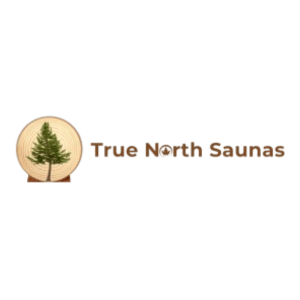ALL YOU NEED TO KNOW ABOUT OUTDOOR SAUNAS
The outdoor sauna has a long history, and has evolved over thousands of years, from a means of survival and purification to a therapeutic temple of sorts. Today, saunas are enjoyed for the variety of health benefits they provide, including detoxification, improved heart function, and weight loss.
If you are considering buying an outdoor sauna, you probably have a few questions about how they came to be. This article will answer those questions!
You will get clarity on the various types of saunas designed for the outdoors, and how they are built to withstand the elements. You will also discover how your outdoor sauna will compare to an indoor version of the same type.
In short, this article will cover everything you need to know about outdoor saunas, which are also sometimes referred to as “backyard saunas.”
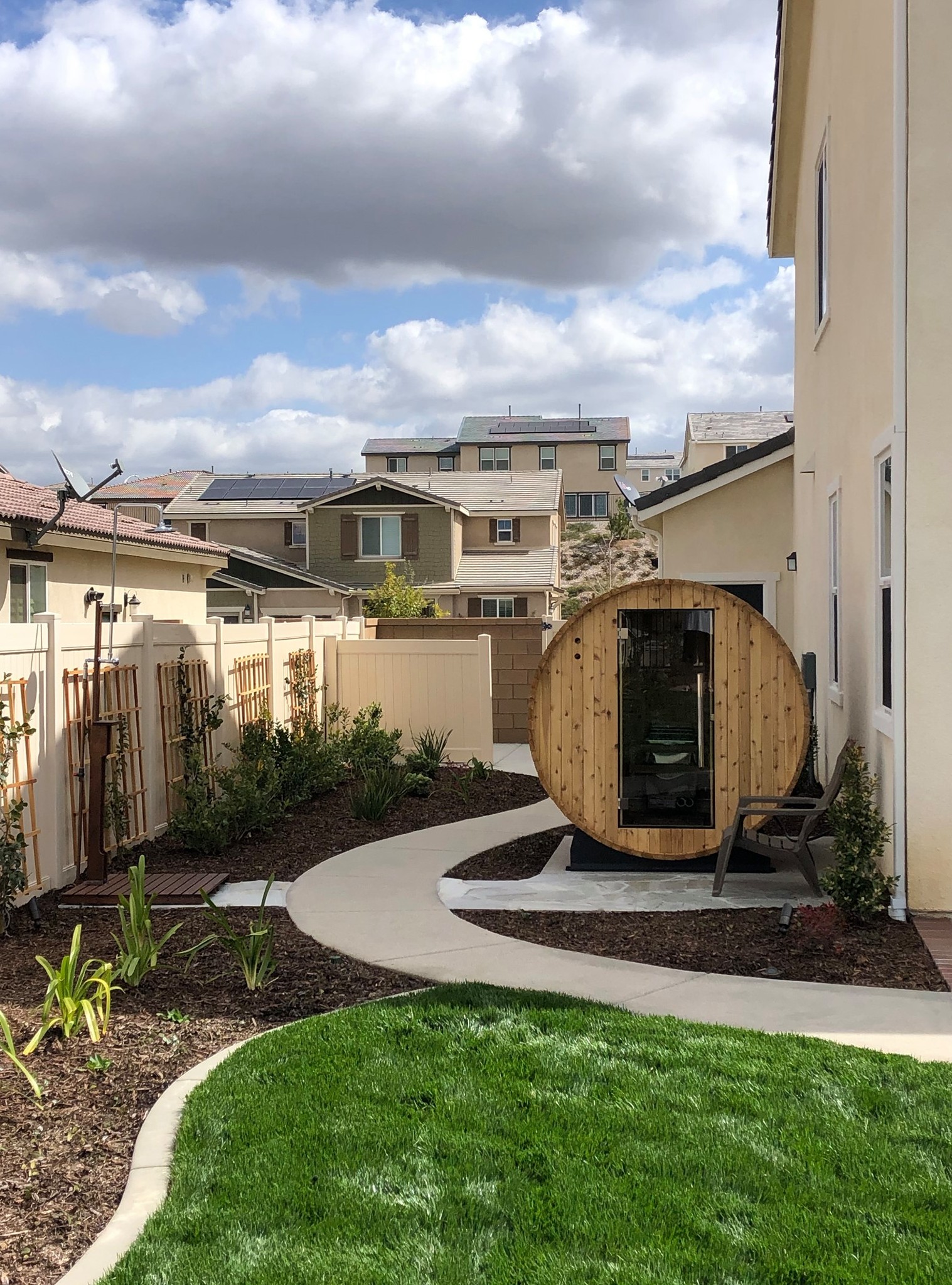
WHAT IS AN OUTDOOR SAUNA?
All saunas are rooms created for relaxation, detoxification, and purification through wet or dry heat therapy. For the most part, saunas built for the outdoors function in the same way as indoor saunas, but with a few differences.
Both traditional indoor and outdoor saunas can create steam, using a heat source, sauna stones, and water. Infrared saunas, which give off a dry heat, can be obtained for outdoor use, but are more commonly found indoors.
Saunas designed for the outdoors are built with special materials that are perfect for dealing with the effects of the weather and drastic changes in temperature. There are a few other factors that set outdoor saunas apart from their indoor counterparts:
-
Most indoor saunas come in a standard box or cube shape, whereas saunas for the outdoors are available in a wider variety of designs.
-
It is easier to vent an outside sauna than an indoor one, but installation can be more complicated. Local building codes must be followed when you build a sauna outside the home - particularly regarding the wiring and the chimney.
-
Saunas made for indoors are usually a lot more compact than those intended for the outdoors.
THE ORIGIN OF THE OUTDOOR SAUNA
Nobody knows precisely when and where the use of outdoor saunas began, but scientists believe that it may have been around 2,000 BCE, somewhere in northern Europe.
The very first saunas were probably something like a man-made cave, closed up with water-resistant animal hides to keep out the wind, snow, and rain.
Here are a few interesting facts about the saunas of ancient history:
-
Due to their long-lasting heat and the sterilizing qualities of the smoke, sauna rooms improved the health and hygiene of their occupants, helping with everyday survival.
-
The saunas of yesterday often served more than one purpose. For example, they were used as birthing rooms, washrooms, kitchens, gathering spaces for celebrations, and even mortuaries where the dead were prepared for burial.
-
They often served as homes, too, as they were easy to keep warm, increasing the chances of the occupants surviving the extremely cold winter months.
-
The healing and therapeutic benefits of these saunas led to them becoming traditional holy spaces, and some cultures believed in sauna spirits who would aid in the healing. Even today, some believe that saunas have magical properties.
TYPES OF OUTDOOR SAUNAS
There are three main ways in which backyard saunas differ from one another:
-
The heat source.
-
The shape.
-
The size.
HEAT SOURCE
Saunas produce heat in one of two ways - traditionally or “non-traditionally,” which just means any sauna with an infrared heater. Here is some insight on how these heat sources work:
THE TRADITIONAL SAUNA
Traditional saunas function in a very similar way to the previously-mentioned ancient saunas, and are known as “wet saunas” or “steam saunas.” Here’s how you use this particular type of sauna:
-
You place sauna stones on top of the sauna heater to warm up.
-
Once the stones are hot, you can sprinkle water on them, creating steam.
-
The steam circulates within the room, raising the temperature and causing you to perspire.
Many fans of outdoor saunas prefer the traditional option, because it provides a more authentic feel. Modern versions of traditional saunas can be heated in two ways, either with a wood-burning heater, for a very authentic experience, or with an electric heater.
WOOD BURNING STOVE
-
Saunas with this heater type use firewood in the wood-burning stove to heat the rocks.
-
Users will find themselves surrounded by an aromatically pleasing ambience.
-
No wiring is required for use of this sauna type.
-
A chimney must be installed for this sauna type to function.
ELECTRIC HEATER
-
In these saunas, an electric heater is used to heat sauna rocks.
-
Electric heaters are the standard option in Almost Heaven Saunas.
-
Electric sauna heaters have a faster heating time than wood-fired saunas.
-
With electric heated saunas, you can control the temperature at any time.
THE INFRARED SAUNA
Infrared saunas have a more focused, modern approach to heat therapy. Rather than heating the whole room, like a traditional sauna, an infrared sauna creates radiant heat with its infrared heater. Although the temperature of the room will not be as high, your body will absorb this radiant heat, and you will sweat. Infrared saunas are proven to be seven times more effective than traditional saunas at detoxifying the body.
SAUNA STYLE
Whether you are looking for a simple, quaint sauna that will add a cottage-like look to your yard, or for something more modern and stylish, there are a large variety of styles to choose from for your new sauna.
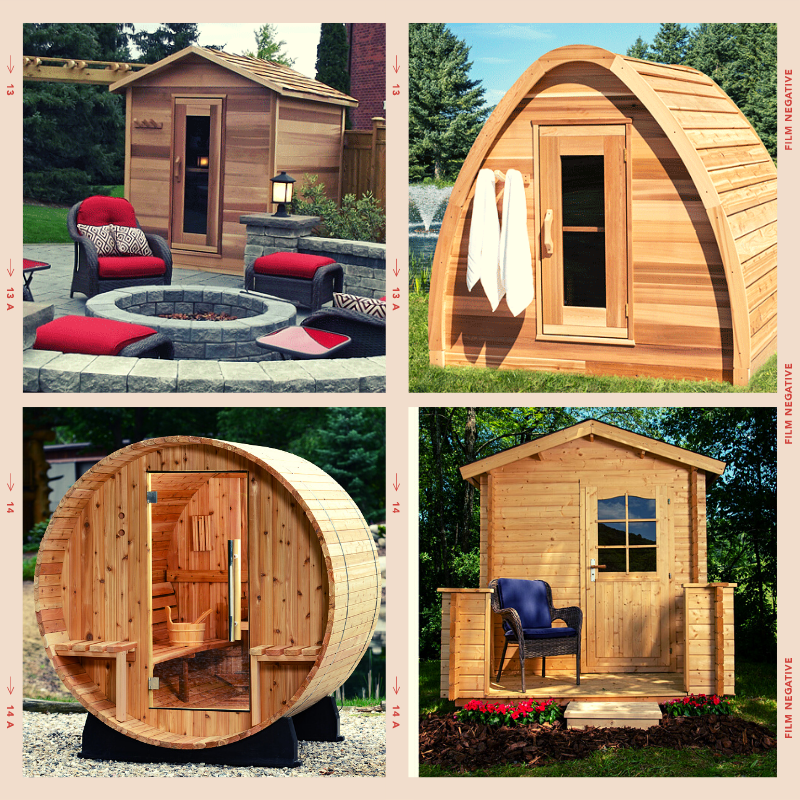
Almost Heaven provides plenty of gorgeous barrel sauna options, while Dundalk LeisureCraft have several new and trendy sauna designs.
BARREL SAUNA
-
The barrel sauna showcases a noteworthy, uniquely circular design.
-
These saunas shed water naturally, making them last longer in inclement weather.
-
Barrel saunas can be used indoors, but are much better suited to use as outdoor saunas.
-
Due to their round shape, barrel saunas have quicker heating times than other sauna styles.
-
They also offer better air circulation.
-
If you buy a barrel sauna for outdoors, it will arrive ready for installation, with no further insulation needed.
POD SAUNA
-
This is one of the newer sauna styles on the market.
-
Pod saunas have an innovative, stylish, rain-drop shape.
-
The taller shape provides users with some extra headspace for better comfort.
-
As an optional extra, you can add on a chic overhang cove to shelter the entrance.
-
Pod saunas feature a durable, triple layer roof.
-
No added insulation is required on installation.
LUNA SAUNA
-
Luna saunas showcase an eye-catching, modern design.
-
They are particularly eco-friendly.
-
Luna saunas have 2-tier benches with rounded corners for extra comfort.
-
Due to their square shape, luna saunas offer plenty of inside space.
-
They have 2 large, bronze-tempered windows, providing users with an abundance of natural light flow.
KOTA SAUNA
-
The Kota sauna is built with a modern approach to design.
-
This is the only sauna style that features a hexagonal shape.
-
The Kota sauna features a triple-layer roof for added durability.
-
No additional insulation is required.
EAGLES NEST
-
The Eagles Nest looks like a small house, making it easy to match with your home.
-
There are 3 sizing options to choose from: 8’x6’, 8’x7’, and 8’x8’.
-
The eagles nest has a fully-tempered glass door for added light flow.
SAUNA SIZES
There is no one-size-fits-all backyard sauna - people have different needs and desires, so there are various sizes available to choose from. Choose your sauna size according to an energy and space efficiency that will suit you best. Here is some more information on the various outdoor sauna sizes available:
-
1-Person Traditional Sauna: This is the smallest option, perfect for enjoying your rejuvenating sauna sessions alone. If you plan to always relax solo, this is the best option for you.
-
2-Person Traditional Sauna: This works better if you plan to bring a companion along on some of your sessions. Whether your companion is your spouse, a close friend, or a new acquaintance, two people can fit comfortably in this size sauna.
Example: Almost Heaven Salem 2-Person Standard Barrel Sauna.
-
4-Person Traditional Sauna: If you plan on enjoying your sauna with larger groups, like your spouse and kids or a few close associates, choose this option.
Example: Almost Heaven 4-Person Pinnacle Standard Barrel Sauna.
-
6-Person Traditional Sauna: This works better if you plan to bring a companion along on some of your sessions. Whether your companion is your spouse, a close friend, or a new acquaintance, two people can fit comfortably in this size sauna.
Example: Almost Heaven 6-Person Princeton Standard Barrel Sauna.
-
8-Person Traditional Sauna: This is the largest option, ideal for hosting a big group of guests.
THERMALLY MODIFIED WOOD
There is a range of saunas with a difference that is well worth mentioning. Thermory saunas are built with thermally-modified wood, making them stronger, more durable, and more beautiful than many of their brethren.
Thermally-modified wood is any type of wood that has undergone a process of heating in a low-oxygen environment, that dries it out completely, forever changing its chemical make-up. After the wood is cooled, it is once again moisturized, and what is left is an extremely strong and stable wood that is eco-friendly, lightweight, and bio-resistant.
ARE OUTDOOR SAUNAS BETTER THAN INDOOR SAUNAS?
Saunas inside and outside the home both provide a host of health benefits, including:
-
Lowered blood pressure.
-
Reduced inflammation of the lungs.
-
Improved ability to fight off the common cold and flu.
-
Removal of harmful toxins from the body.
-
Assisted weight loss and management.
-
Clearer skin, free of acne and blemishes.
-
Stress relief, and the opportunity for meditation.
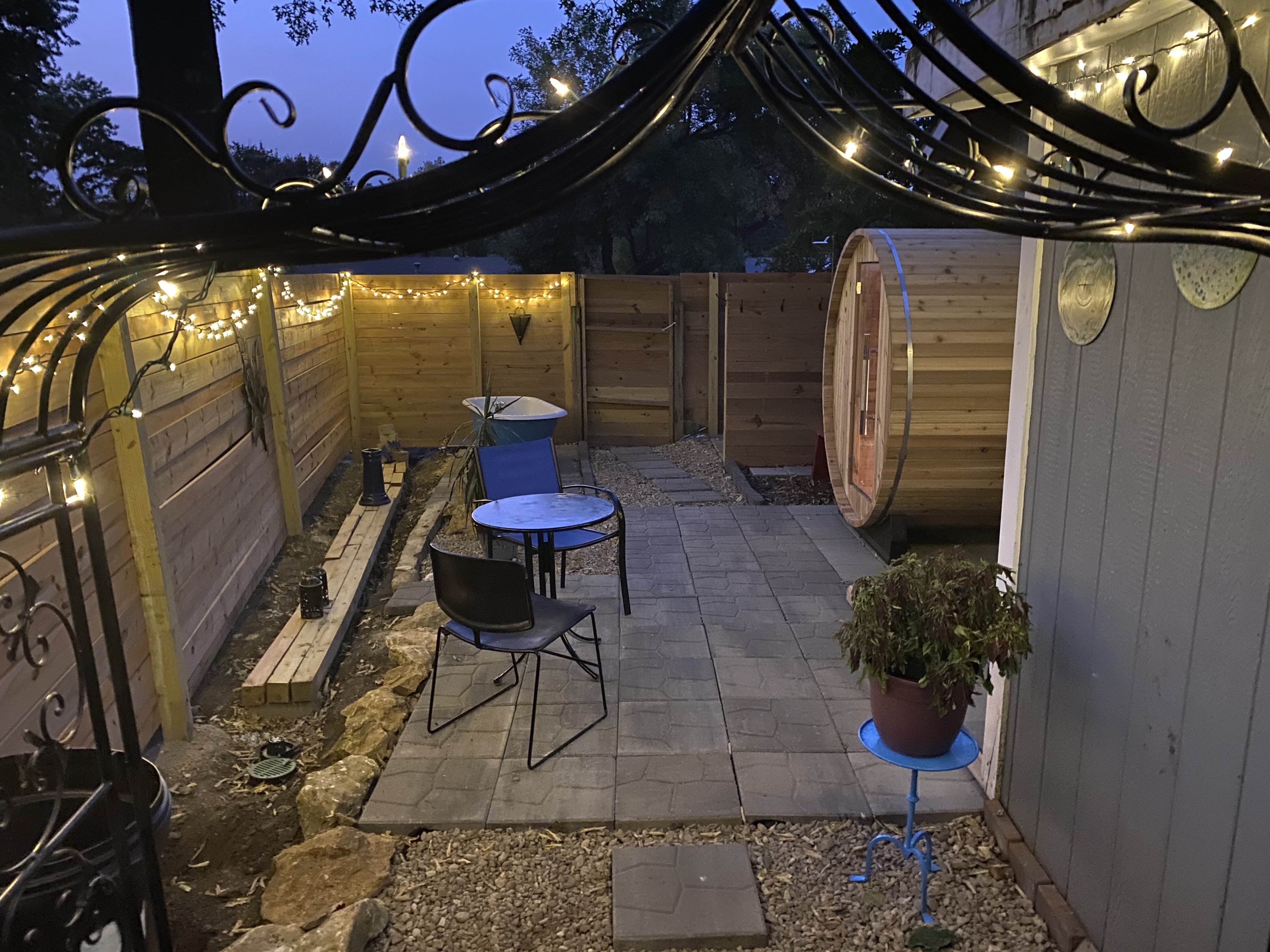
While both options are practical and useful, there are a number of reasons why you may prefer to place your sauna in your backyard:
-
Building your sauna outside your home will save valuable space indoors.
-
If you would like to add some charm to your garden while increasing your property value, an outdoor traditional sauna may be the better choice for you.
-
A sauna placed conveniently just outside your front door provides a quick getaway, without you needing to leave your property.
-
You can use your sauna as a pool house if it is outdoors, and you can even make use of your pool in the winter by taking quick dips during your sauna sessions.
MAINTAINING YOUR SAUNA
The expert craftsmanship used in creating modern outdoor saunas ensures decades of use. The oldest working sauna in the world was built in the 20th century, and it is still functioning today. This is a good sign that with proper care, your sauna can last a lifetime.
Here are some cleaning and maintenance tips that will help you keep your sauna up and running for years to come:
BEFORE EACH SAUNA SESSION
-
Clean your feet before you enter your sauna, to cut back on dirt and sweat build-up. By doing this, you will also reduce the chance of mold growth inside your sauna.
-
Take a shower before your sauna session to cut back on the amount of dirt, sweat, and grime you would otherwise leave on the benches and floors after each use.
CLEANING YOUR SAUNA
-
You should vacuum or sweep your sauna regularly, and clean more deeply at least once a month.
-
Always make sure your sauna is turned off while you clean. It is not wise to do hard work in the higher temperatures, and your cleaning products could release harmful chemicals when exposed to the heat.
-
Try to use only chemical-free products and warm water. Baking soda mixed with water is a very effective and safe cleaning agent.
-
To remove stubborn, tough stains or scuff marks, use a fine-grit sandpaper.
-
You can pressure wash the inside of your sauna if you feel you need to - use a wide-patterned nozzle with a low pressure setting.
CARING FOR THE WOODEN INTERIOR OF YOUR SAUNA
-
Avoid using hard water if possible. Magnesium and calcium salts will cause lime buildup, and you will have to use sanding discs to get rid of it.
-
Do not use protectants or sealants inside your sauna to prevent the wood from absorbing moisture - the heat will cause toxic chemicals to release from the substances.
-
Always use towels during your sessions, and have extras on hand for your guests. Wash them immediately after each use.
-
Wipe the wooden interior of your sauna with warm water and a soft cloth regularly. This will keep the wood looking new.
-
If your lumber warranty has expired and your wood is looking faded, simply sand down those areas to touch them up. Clean away the wood chips when you are done, or you may get splinters during your next session.
CARING FOR THE WOODEN EXTERIOR OF YOUR SAUNA
-
If you choose to treat the outside of your sauna, you should use a wood-penetrating oil.
-
For deep cleaning, use a pressure washer that is set on low.
-
If you choose to stain the outside of your sauna, be sure to use a product with a UV inhibitor, as this will help your wood resist sunlight.
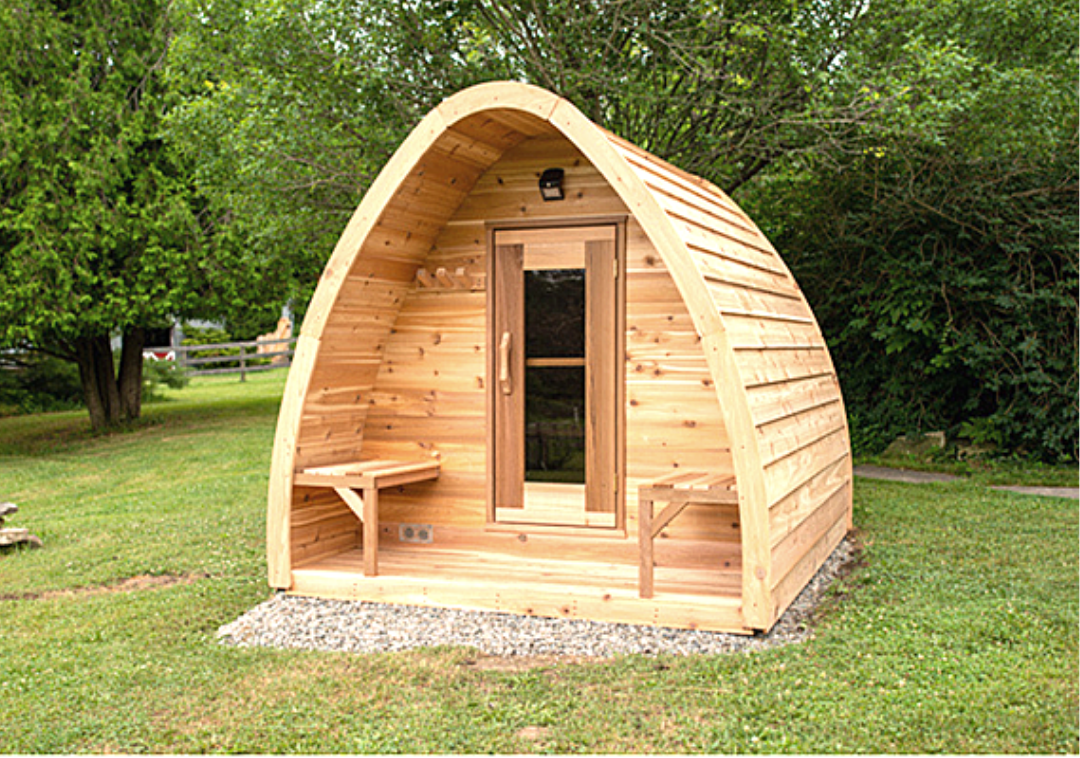
SIGN UP. SAVE BIG.
Subscribe to be the first to know about our special monthly sauna sales, sent right to your inbox.
SAUNA HEATER, DOOR, AND VENT CARE
-
Sauna stones are extremely low-maintenance - simply wipe yours down with a soft cloth. Well-kept sauna stones last for years.
-
Check the doors and vents of your sauna heater regularly, and replace any lost screws as needed. Loose hinge screws will require longer replacement screws.
-
If your sauna door will not close properly, sand down any uneven areas.
-
If your sauna door keeps swinging open, try adjusting the ketch. You can add a small piece of cardboard if necessary.
-
Sand down the slider corners to reduce the drag of your sauna vent.
ONGOING SAUNA MAINTENANCE
-
If your sauna stones happen to crack or split open due to the temperature changes, be sure to replace them as quickly as possible.
-
As far as possible, only use stones designed for your sauna heater. If you do have to gather your own stones for a quick fix, choose good, dark stones that can retain heat.
-
During the first few months of using your sauna, you might have to tighten the bands.
-
As time passes, you may have to add more filler staves - this is normal.
SUMMARY
As you begin to use and enjoy your new backyard sauna, you will come to realize that your investment is quite practical, as well as calming and rejuvenating.
Both indoor and outdoor saunas have many health benefits that will leave your body feeling refreshed after each relaxing session. Because the outdoor saunas come in a variety of shapes and sizes, you will have no difficulty finding an option that perfectly suits your needs.
While choosing your sauna, remember that the heat source, the design, and the size are what set the various outdoor saunas apart from each other.
For more information on backyard saunas, as well as any related accessories, be sure to regularly visit our My Sauna World Blog.

About the Author
Adam Fromson
Adam Fromson, co-founder of My Sauna World, loves saunas and their transformative health benefits. With years of experience exploring sauna culture and its impact on health and wellness, Adam is passionate about helping others discover the life-changing benefits of saunas for themselves.
Let customers speak for us
from 385 reviews
Good communication, easy delivery, easy set up, easy operation, great value. Recommended!
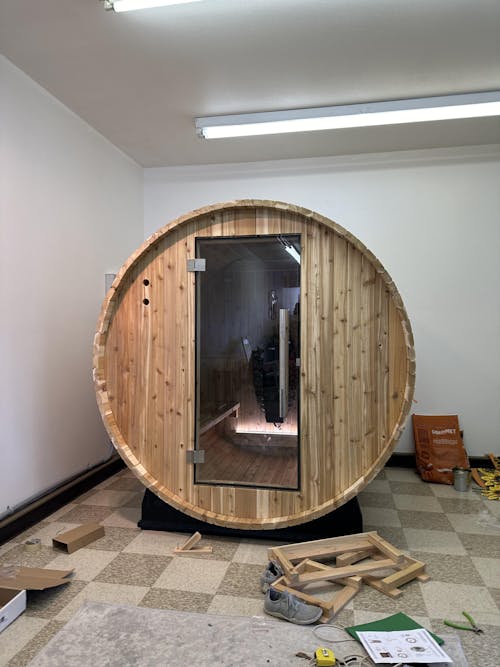
We ordered the 4 person barrel sauna and love it! We wanted a little extra space for the 2 of us/guests and it’s great. We could definitely fit 4 people in it if we needed. We use it every single day. It took about 10 weeks to get here because they build it specifically for the order. Putting the barrel together was fairly easy with 2 people. The electrical and the heater definitely required an electrician to install as we could have not done it alone.
We ordered the biggest heater (harvia spirit 8kw) and it heats up the sauna in about 15 mins inside our 40-50° garage. Overall this style of sauna is hotter and you sweat a lot faster than in an infrared sauna. I truly 10/10 recommend!
Pic is of us in the middle of building it.
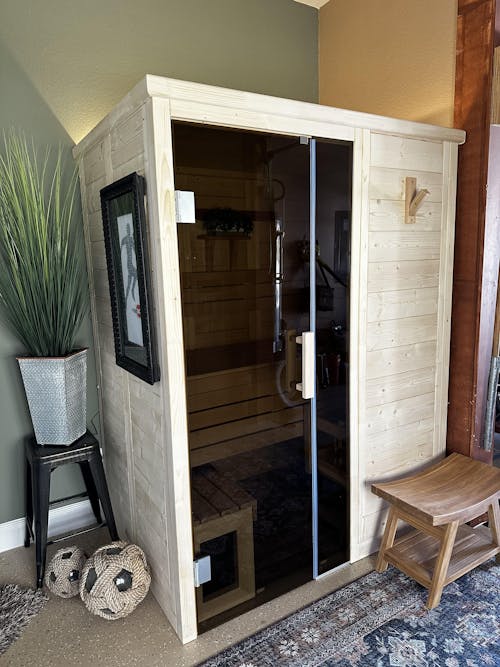
Took me about 6 hours over 2 evenings to assemble almost all by myself. Had a pro run a new circuit from my panel. Very well made and assembly was straightforward. Heater is well sized and reaches operating temperature in under 30 minutes.

Great sauna very easy to assemble
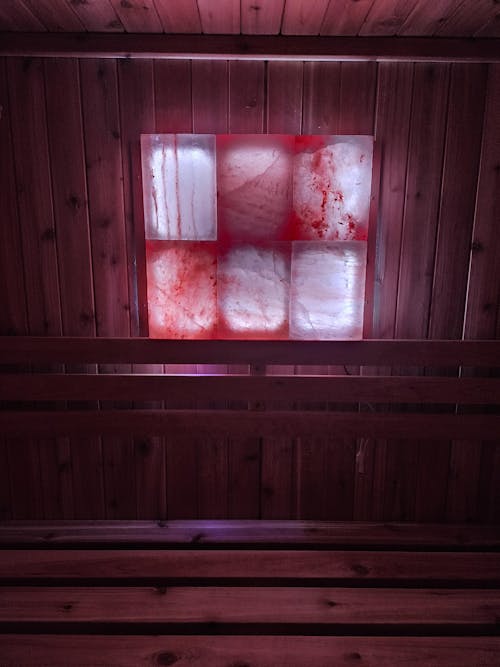
The salt panel was a great addition to our Madison Sauna. It has excellent grain which is accented by the amazing color lights that glow through the panel. Also when you hit the rocks with a splash of water you can feel the heat bounce off the panel. Great addition if you are considering this option.
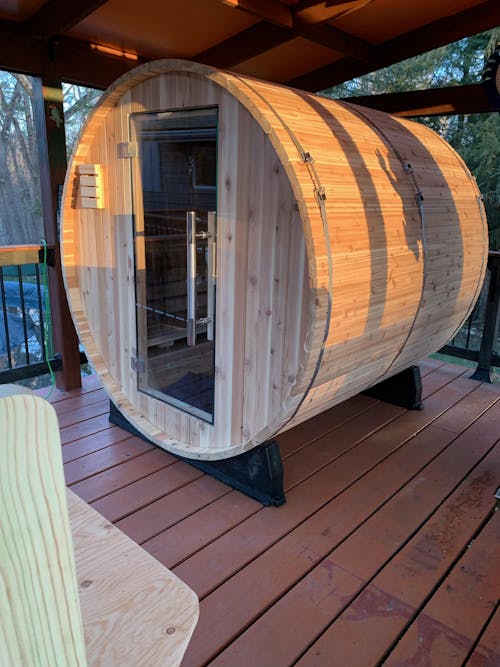
We can say enough about Sauna World there customer support is great! Our Pinnacle Sauna from Almost Heaven is epic.
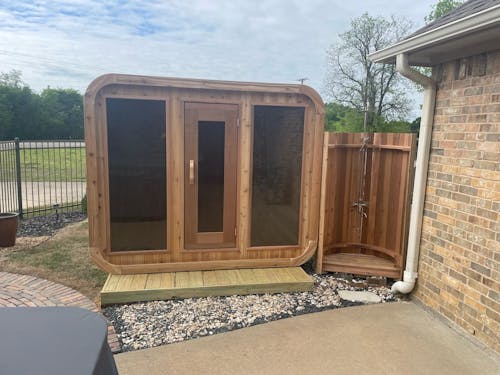
The finish and quality is outstanding and it was quick and easy to assemble.
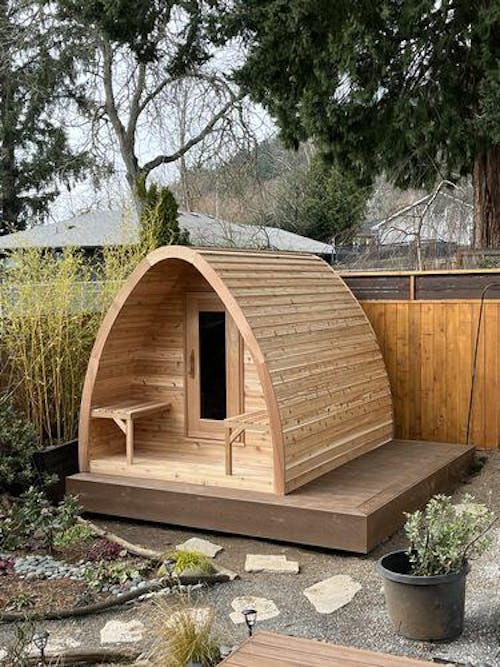
We are thrilled with our mini pod!! It came well shipped and our friend assembled it in 11 hours! Wow! We cannot wait to get healthy and sauna it up!
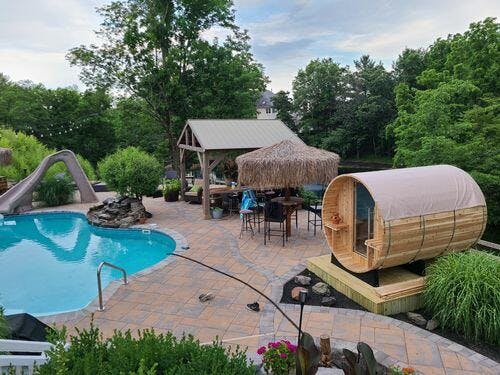
Beautiful sauna!!! Much easier than I expected to assemble, took a total of 4 hours. Can't wait to get warm by the pool on those cool evenings. Customer service was excellent..

Purchased a 2 person Almost Heaven barrel sauna and were delighted with the product. The order process was quick and easy, the sauna arrived on-time, installation was simple, following the provided instructions, and the sauna is extremely high quality. We’ve used it daily for over 2 weeks and quite frankly I don’t know how we lived without it. If I had it to do over again I wouldn’t change a thing... except maybe purchasing a 4 person model to easier share with friends!
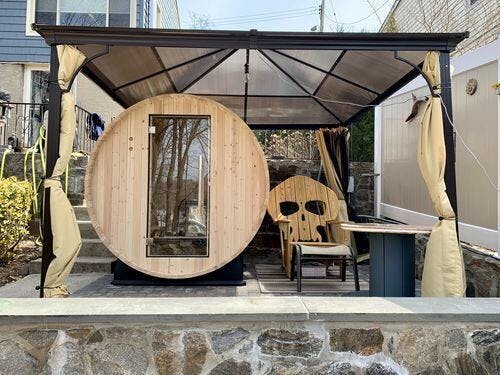
Great Customer Service and a breeze to put together.Excellent shipping and the Sauna is top notch, couldn’t be happier



















